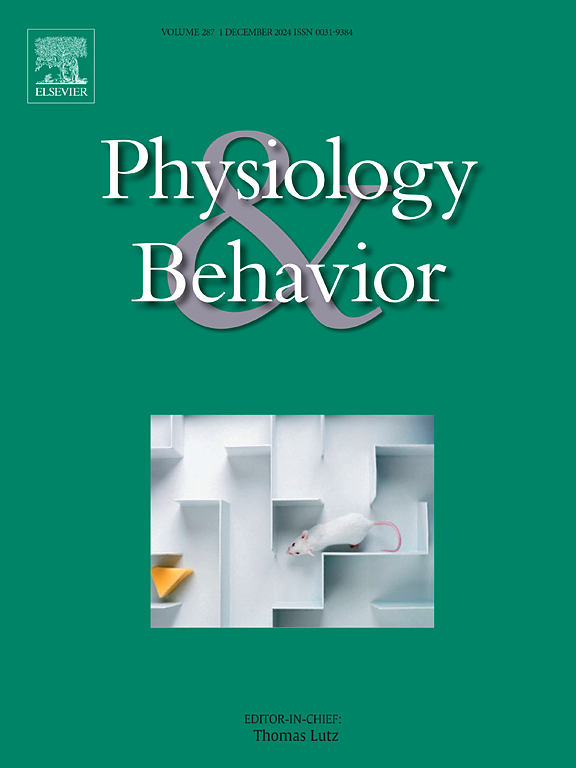Mounting exhibited between cows is not associated with sexual motivation
IF 2.4
3区 医学
Q2 BEHAVIORAL SCIENCES
引用次数: 0
Abstract
Females of various species exhibit mounting behavior toward other mature females, i.e., female–female (f–f) mounting. Cows exhibit f–f mounting, which is commonly considered a sexual behavior based on a few similarities with male sexual mounting. Here, we hypothesized that the degree of f–f mounting exhibited by cows in estrus would increase when they are sexually motivated by sexually relevant stimuli. To test this hypothesis, two groups of four cows each were prepared. First, estrus was induced in one of the cows in each group by injecting estradiol in the presence of a non-sexually active male steer as a stimulus animal (steer-stimulus condition), and all f–f mounts were recorded. Estrus induction was repeated until induced in all cows. We then changed the stimulus animal from the steer to a sexually active bull (bull-stimulus condition), and the estrus induction procedures were repeated as before. We confirmed that estrus was induced successfully in cows injected with estradiol and that they were sexually motivated by switching the stimulus animal from steer to bull, as they spent relatively more time with the stimulus animal in the bull-stimulus than in the steer-stimulus condition and when not in estrus. However, f–f mounting frequency in the bull-stimulus condition showed no significant difference to that in the steer-stimulus condition. We observed that six of the eight subjects exhibited f–f mounting when not in estrus, which accounted for 44.6 % of f–f mounting we observed (n = 668). These findings suggest that f–f mounting in cows is not associated with sexual motivation.
奶牛之间表现出的骑乘与性动机无关。
不同物种的雌性动物都会对其他成熟雌性动物表现出雌-雌(f-f)交配行为。奶牛表现出的雌-雄上马行为通常被认为是一种性行为,因为它与雄性的性上马行为有一些相似之处。在此,我们假设,当母牛受到与性相关的刺激而产生性冲动时,它们在发情期表现出的雌-雄上马程度会增加。为了验证这一假设,我们准备了两组奶牛,每组四头。首先,通过注射雌二醇诱导每组中的一头母牛发情,同时将一头无性活动的雄性骏马作为刺激动物(骏马刺激条件),并记录所有雌雄交配的情况。反复进行发情诱导,直到所有母牛都诱发发情。然后,我们将刺激动物从骏马换成性活跃的公牛(公牛刺激条件),发情诱导程序如前。我们证实,注射了雌二醇的母牛成功诱发了发情,而且将刺激动物从骏马换成公牛后,它们有了性动机,因为在公牛刺激条件下,它们与刺激动物在一起的时间比在骏马刺激条件下和未发情时相对要多。然而,在公牛刺激条件下,f-f 安装频率与在骏马刺激条件下没有显著差异。我们观察到,8 名被试中有 6 名在非发情期表现出雌雄交配,占我们观察到的雌雄交配的 44.6%(n = 668)。这些研究结果表明,奶牛的雌雄交配与性动机无关。
本文章由计算机程序翻译,如有差异,请以英文原文为准。
求助全文
约1分钟内获得全文
求助全文
来源期刊

Physiology & Behavior
医学-行为科学
CiteScore
5.70
自引率
3.40%
发文量
274
审稿时长
47 days
期刊介绍:
Physiology & Behavior is aimed at the causal physiological mechanisms of behavior and its modulation by environmental factors. The journal invites original reports in the broad area of behavioral and cognitive neuroscience, in which at least one variable is physiological and the primary emphasis and theoretical context are behavioral. The range of subjects includes behavioral neuroendocrinology, psychoneuroimmunology, learning and memory, ingestion, social behavior, and studies related to the mechanisms of psychopathology. Contemporary reviews and theoretical articles are welcomed and the Editors invite such proposals from interested authors.
 求助内容:
求助内容: 应助结果提醒方式:
应助结果提醒方式:


